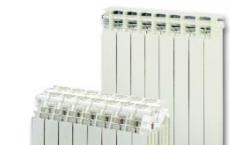Alternative power supply. Alternative sources of electricity
Tariffs for energy are constantly rising, forcing us to turn to natural sources of energy. Alternative sources energy is almost inexhaustible, used by mankind at 0.001%.
Mankind uses not renewable sources of energy for energy production - coal, gas, oil. The reserves of which may not be enough already for the living generation, therefore energy carriers are constantly becoming more expensive. The modern family spends up to 40% of the budget on light, heating, fuel for cars. According to forecasts of economists in the next 15 years, the cost of energy will be the main - up to 70%.
Almost any natural factors can be turned into energy: the sun, wind, water movements, subsoil heat, decomposition of biomass. In Russia, for a private home, the most relevant are the energy of the sun, wind and subsoil heat. Water energy - tidal, pressure, geothermal sources are difficult to implement technically, there may be problems with the use of subsurface resources beyond the boundaries of the site.
The issue of using natural resources has not been worked out at the legislative level. According to the current legislation, all natural resources belong to the state. Therefore, even the use of solar energy can theoretically be taxed.
Wind
People use wind energy for a long time, effectively learned to use 40 years ago with the construction wind power. The wind generator is a system of blades connected to the generator via a reducer or directly. Acceptable indicators of wind generators reach a mast height of more than 15 meters, which in a private house is problematic. Low masts "work" 15% of the days a year, high - up to 30%.
Modern development of the shape of the blades has adapted the wind generators to all conditions of operation and air movement: slow-moving, high-speed, rotary.
Low-speed ones are designed for wind speeds of 2-6 m / s, represent a wind wheel with a large number of blades 15 - 30 pcs. They are low-noise, well run into a small wind, but have low efficiency and large sail. 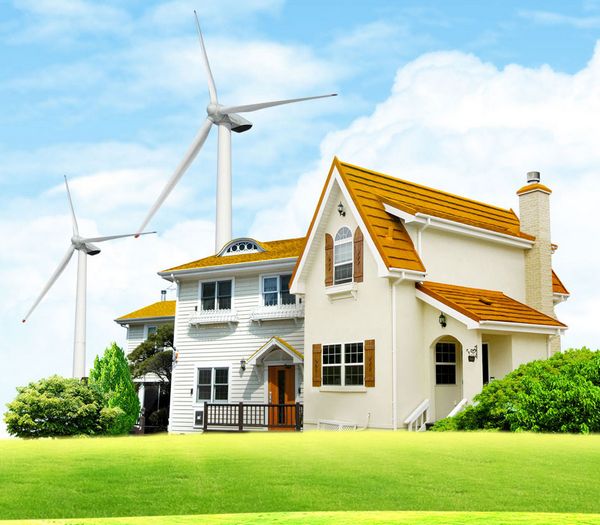
High-speed boats are designed for wind 5 -15 m / s, have 3 - 4 blades. They are characterized by high efficiency and noise, the most common in the world.
Rotary are a barrel with vertical blades. Do not require orientation to the wind, the lowest level of noise, but all cross out the lowest efficiency.
The use of wind generators in private housing construction makes sense as one of the sources of energy. 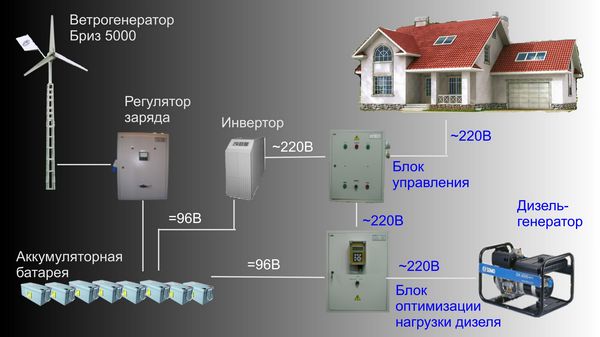
The sun
Solar energy is the most promising source of inexhaustible energy. For a year on the surface of the earth, solar radiation hits 30,000 times more than the annual consumption of electricity by the entire population of the planet. Constant work is under way to improve the efficiency of photoelectric converters and solar panels. This allows them to be used for industrial production electric power.
Self-production of photovoltaic panels and solar water heating systems is possible. However, the parameters of such plants are at best 40% of industrial models. Particularly demanding in the quality of manufacturing solar water heating system. Industrial with vacuum tubes allow heating water for heating and domestic needs even in frost, it would be sunshine.
Solar systems can be divided into direct and indirect heating. Direct - it's greenhouses, hotbeds, tanks heating water in the sun. A glazed loggia or a veranda is also a source of heat, only it is used irrationally. Indirect heating allows you to place a heat production plant in the sun in a convenient place - a roof, any open space. Most often, non-freezing liquids are used as a coolant, heat transfer takes place in heat exchangers - storage tanks, from which there is water for domestic needs and heating.
Modern solar power plants are produced in two types - tubular and flat. Flat ones are a box with a spiral-shaped blackened heating element, more often a copper tube. The spiral is thermally insulated from three sides, on the side of the sun is covered with glass. Such an installation is cheap, available for self-made, but has a low efficiency. The coolant is water or an antifreeze coolant.
Tubulars are a block of parallel tubes from 1.3 to 4 m in height. The number is recruited anyway due to the ease of interfacing the tubes with the collector by a dry-connection method, in which a set of tubes and their replacement occurs during operation. The tube is a glass vacuum flask with an internal black light absorption tube filled with a special coolant with a low boiling point, which increases the efficiency of the installation. Tubular solar power plants are 30% more economical than flat ones, but more expensive when purchased. For effective operation, they are equipped with a pump, a system of thermally insulated pipelines, and a heat exchanger. Such a panel is fixed permanently due to its large weight - up to 300 kg with a slope to the horizon, for the latitude of Moscow - 30 degrees.
For the central zone of Russia, tubular solar water heating systems that work efficiently at any air temperature find the greatest practical application in individual construction. Are able to provide not only the need for hot water, but also participate in heating. 
Ground Heat
Everyone has heard about heat pumps that allow to take the free heat of the earth and to be heated for free. The principle of their action is based on the collection of any low-temperature potential and its transformation into heat. Everything is suitable, from which you can take a positive temperature: the ground, water - a well or a pond, air. The physical processes are the same as in the compressor of the refrigerator, only on the contrary, it produces not heat, but cold. In a closed circuit, a liquid with a low boiling point circulates, taking heat from the environment boils, condensing - gives heat to the home.
But you need to critically approach the assessment of the possibility of new-fangled heating systems. The temperature at the outlet of the heat pump is 40-60C, usually 40C, which is good for warm floors, but not for radiator heating. The cost of reliable European heat pumps starts from $ 8000, which is unreasonable for the average Russian - it will never pay off. In addition, it is necessary to remodel or supplement the existing heating system under the warm floor, to connect it with the heat pump system. Even with a ready-made well - the most efficient heat exchanger, the heat pump system will cost at least $ 12,000.
Economic feasibility is possible in the manufacture of a heat pump by one's own hands, which can be made from a compressor of a refrigerator from 1.5 kW. The technology of reworking is well presented on the Internet. 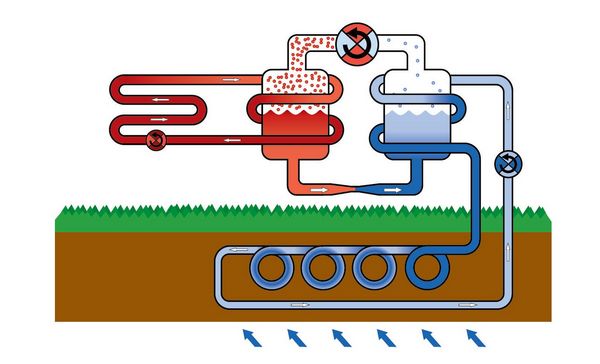
All right, all right
For the opportunity to save energy, all the means described above should be used. By themselves, photocells and wind turbines are not expensive, the more they can be manufactured independently. Effective use of them is possible only with batteries (AB) and voltage converters. And this already needs to add 50% of the cost of the units. It is parallel work on the AB photo and wind generators that allows to achieve notable results. The work of all heating elements is suitable for the heat accumulator, allowing "to store" the heat for future use for heating and hot water. But most importantly, where to begin saving - this is the insulation of the house. Without warming to achieve any noticeable results is impossible. 
Today, electricity in the cottage is no longer a luxury: a comfortable rest and effective maintenance of the site is difficult to imagine without the appropriate equipment, so that sooner or later it will be necessary to think about energy supply.
Naturally, there are many nuances in this process, and therefore we strongly recommend that you familiarize yourself with this article. Of course, we will not reveal all the subtleties, but you will get a general idea of the scope of the forthcoming work.
Where to get?
Traditional sources
And if we confine ourselves to traditional technologies, then there are only two schemes for energy supply:
- Centralized - the area is "fed" from a relatively short distance power transmission line.
- Autonomous - as a source is the generator.
Let's consider both options in more detail.
- If we talk about the use of centralized power supply, the main advantage is a sufficiently high power supply. So, in this case, you can even arrange heating of the dacha with electricity, without ruining the fuel for the generator.
- On the other hand, the very process of connecting to a power line is associated with very tedious bureaucratic procedures. Even if the wires are laid relatively close, problems may arise at the coordination stage.
Note! Unauthorized connection to the power line is an offense, and if you find such a fact you will have to pay a considerable fine. Also it is worth remembering that such works should be performed only by professionals with the appropriate level of tolerance.
- Renting a diesel generator for a dacha or buying such a device can provide you with energy regardless of the site location. Yes, this technology is more expensive from a financial point of view, but you can be sure that light in the house and on the site will not be lost even during a bad weather (wire breaks, especially in remote areas, are not uncommon).
- Another option for autonomous power supply is the installation of a gas generator. Of course, the price of the device will be higher than that of a diesel engine, and only specialists can serve it, but the cost of a kilowatt of energy will turn out to be much lower.
In the end, the optimal instruction will be as follows: if possible, we connect to the power line and use its power, but just in case, we install a generator in the house or barn with a small fuel reserve. If there is no connectivity, we simply buy a more efficient generator, and we design the grid with a look at the performance limitations of the installation.
Alternative sources
However, modern technology allows you to get electricity for free to give. Under the "freebie" in this case there is complete or almost complete independence from energy prices. Of course, the alternative equipment itself needs to be purchased, and for quite a lot of money, but over time (from two to five years) it pays off, and then it works "in plus."
Some of the most effective technologies can be identified, and their features we have reduced to the table:
| Methodology | Power generation features |
| Geothermal | At the site, we drill a well into which we immerse a probe with a coolant. Since in the depth of the soil the temperature is practically constant, when passing through the probe the cooled coolant will take part of the ground heat. The extracted energy can be used both for direct heating of the house, and for generation of electricity. |
| Solar | On the roof, either solar collectors are installed from glass tubes filled with a coolant, or solar panels. As in the case of geothermal installations, the energy of the sun can not only heat the house, but also feed the inverter to provide electricity. |
| Windy | On the roof of the house or on a separate mast, we install a windmill connected to the generator. When rotating the blades, electricity is generated, which accumulates in large-capacity batteries and can be used to solve a variety of tasks. |
However, such free power supply is rather capricious. No wind or the sun went down behind the clouds for a whole day - and you'll have to sit in the dark! That's why experts strongly recommend that you equip such installations with capacious batteries, and as a backup power source to keep at least a small diesel generator.
Power installation features
If the sources are more or less clear, we turn to the rules for arranging the power grid itself:
- Installation of wiring and electrical appliances in the holiday home can be done with your own hands, but it is better to entrust the connection to the main line or generator to electricians.
- At the entrance to the house must install a shield with a counter. Also, we attach each branch of wires to the shield through an RCD - an automatic circuit breaker. The use of such fuses can protect the system from voltage drops and short circuits.
Advice! If you often go in the departures, it makes sense to equip the remote inclusion of electricity in the country. To do this, we mount a special module in the shield with a GSM-receiver, which activates the entire system on a signal from a mobile phone. It is especially convenient to use such a controlled unit in the winter time: by your arrival, the heating devices will just have time to warm up the air.
- When using generators, you need to carefully calculate the power of all devices included in the network. For example, heating a holiday home with electricity may require the installation of a separate generating unit, otherwise in autumn and winter it will be necessary to choose: either we have batteries or light bulbs.
- Summer houses from block containers, frame structures and log buildings are highly flammable. To reduce the risk of fire, all wiring should be laid in non-flammable, preferably metal, boxes.
Proper grounding is one of the safety conditions
- It is also desirable to ground the wires. For this purpose, each branch of the system is connected to the ground loop, which is output to the outside. The contour is most often a triangle of steel or copper-plated rods dug in the ground and connected to the house electric network by a conductive cable.
Conclusion
For a more detailed introduction to this topic, we recommend that you view the video in this article: from it you can learn a few new ideas for electrifying your a country house.
Alternative energy is energy, the source of which differs from what we used to use (coal, gas, nuclear fuel, oil, etc.); is more often used in the context of the limited availability of fossil fuel sources and the presence of harmful greenhouse gases into the atmosphere. Alternative energy is a relatively new industry (since there was no need to look for something less efficient but cleaner than coal, for example) does not find a wide number of supporters, but the transition to it is inevitable. When we find ways to extract large amounts of electricity (rather, store it), use hydrogen and other elements, efficient solar or thermonuclear energy to replace familiar sources, the world will change beyond recognition.
Researchers say that if we really wanted to do this, by 2050 almost three quarters of the world's countries could fully switch to the use of renewable energy sources. Such conclusions were made within the framework of a large analytical project to compile a global roadmap until 2050.
The issues of supplying energy to our home are becoming more urgent. And this is due not to the lack of energy carriers or generating capacities.
No matter how sad it sounds, this is due to the "commercial" monopolization of everything connected with the energy and the Government's unwillingness to change the situation in this area.
Nevertheless, there are ways to reduce the financial pressure of power engineers on the family budget, and in some cases, completely abandon their centralized services.
General principle of the inverter and power supply system
Strangely enough, but the progress alternative energy for home using renewable energy sources (RES) is hampered by the ignorance of potential consumers about the technology of obtaining energy in this way, indicators of durability and reliability of the system.
The main element of all systems with RES is an inverter - an electronic device for converting low DC voltage to AC with the characteristics of the network. To control the parameters of the output signal (mains voltage) two "wonderful" qualities of the inverter are used:
- Feedback - the ability of electronics to respond to changes in the state of consumers.
- Pulse generation of the output signal by the electronics of the inverter. Pulses with a frequency of several thousand hertz form an AC sinusoid, and the feedback allows you to take into account the load of the consumer. In addition, high-frequency pulses allowed to reduce losses on magnet reversal of the transformer's iron, which led to a significant reduction in its size.
Another important part of electronic power flow control is a controller that acts as a gateway that distributes the energy flow from the generating device to the drive or inverter.
To judge the energy capabilities of the battery-inverter-consumer system, you can by the following figures:
- The power of the consumer is 14 kW (taking into account a simultaneous load of 60%, we get 8.4 kW).
- Specifications AKB - 24 V, 225 A * h, 4 pcs.
- The inverter is 9-12 kW.
A system with such characteristics can work two days without recharging to discharge the battery by 70%.
Alternative energy sources for home will be considered separately.
Ways of obtaining energy
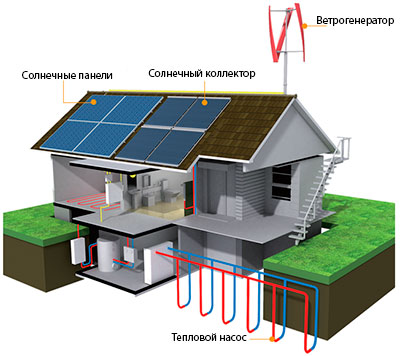
The basic principles of obtaining energy "from the air" were discovered long ago, but for practical use there was not enough level of technical development. With the development of electronics and materials science, this became possible. In terms of technical and material terms, solar panels and wind generators are available to most consumers, but certain conservatism of the Russian population is affected. A heat pump or bioenergy plant is already a serious engineering and technical task. But they are all worthy of attention.
In the Mediterranean countries, solar energy is so developed that the governments of Spain and Italy are closing down government subsidy programs for private consumers.
The efficiency of a solar battery depends on the duration of the illumination and the angle of incidence of light. Both factors in Russia are not very favorable. In its pure form, photoelectronic sources of energy are applicable for a special purpose, as an auxiliary device for recharging the battery. For example, it could be a remote instrument that transmits telemetry data to the base (pipelines, power grids, meteorological stations, etc.). In addition, solar panels have proven themselves in security systems, emergency lighting and systems with low energy consumption.
solar collector
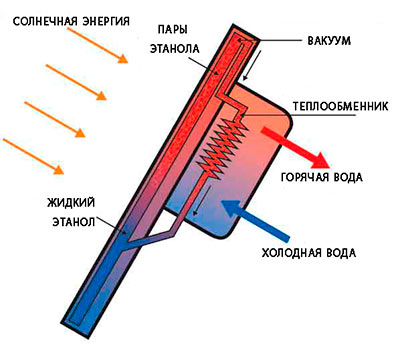
One of the most common and exhausted versions of the heat pump is the solar collector. The low-boiling liquid circuit is a large number of very thin tubes that are placed in a flat light-absorbing panel.
The compressor pumps the liquid through the panel, which ensures its constant heating by sunlight and efficient operation of the heat-extraction circuit.
The solar collector can be used as an independent element dHW systems, and together with a heat pump of underground accommodation or with an electric boiler (from a windmill) for autonomous heating of a residential house.
Efficiency solar collector high enough even in cloudy weather. A thermal accumulator should be provided.
The power of the wind has long served man, but only with the advent of electronics and new materials it became possible to use light wind (2 points, up to 3.3 m / s on the Beaufort scale) and not be afraid of storm loads (10-11 points, 30 m / s and more).
The wind generator with closed metal-ceramic bearings, neodymium magnets, fiberglass blades and a strong body is an absolutely reliable and unpretentious mechanism that fits well to the harsh climatic conditions of Russia. alternative energy for a country house, built on the basis of a wind generator, has a high level of stability characteristics.
Thermodynamic sources (heat pump)
The countless volumes of energy of low-potential heat that are "hidden" in the Carnot cycle (Sadi Carnot, 1824), do not give rest to engineers since its discovery. Modern technologies, materials and achievements of machine engineers with electronic engineers make it possible to realize the theoretical bases of this principle in practice. Compressor and pumping equipment, low boilers, piping system and electronic control system - this not simple technical set of elements is supplemented by a variety of specific application conditions. This explains the complexity of the mass introduction of heating systems based on the principle of a heat pump.
But interest in TN in Russia is growing. With the development of low-rise construction, the number of models offered is increasing. But the trouble is that even Finland (Ultimate), which is closest to us in terms of climate, supplies devices designed for the average annual temperature of the heating period minus 7 degrees, and 70% of the territory of Russia it is minus 12-15. Debugging to the right parameters is not easy.
Bioenergetic sources
The source of this class belongs to the category of sources with complex technological and technical requirements. The biological component of the processes makes demands on temperature and pressure in the fermentation zone, the composition and consistency of raw materials has its parameters, and the final product (methane) requires special working conditions. All this requires large investments. Modern technologies of raw material preparation (coagulation, centrifugation, bio-additives) allowed to reduce the size of the methane tank more than twice. This alternative energy source economically feasible for farms with a stable and sufficient raw material base.
It is very interesting to supplement the bioenergy plant with an industrial wind generator. Dependence on external networks disappears completely, with a high degree of energy security.
Variants of the arrangement of alternative sources
The proposed variants of the arrangement of alternative renewable energy sources proposed in the table can not be a dogma. With feeding from the network of options becomes even greater.
Of course, the cost of equipment and installation are not so cheap, which leads to a long payback period of the project. In addition, the state and the energy sector are in no hurry to redeem surplus energy, which will necessarily appear, because normal calculation is carried out with a margin. But if you, at least once, had to sue the energy company about burnt household appliances or conduct and connect electricity to a remote home and look to the future, then the price does not seem beyond. Terms of service alternative energy sources for cottages or country houses they can raise more than one child in such a house.
| Type of object | Parameters and composition of alternate energy sources | |
| Layout diagram | ||
| Apartment (electronic consumers: TV, computer, music center and lighting.) | 2,0-2,5/60-75 | solar battery - battery - inverter - controller |
| Dacha (pump, refrigerator, TV, lighting). At the rate of 2 days without recharging the battery. | 3,0-3,5/90-105 (summer) |
1) solar battery (30%) - wind generator - battery - inverter - controller; 2) solar battery (100%) - diesel generator - battery - inverter - controller; 3) wind generator - diesel generator - battery - inverter - controller; |
| Country house for permanent residence | 7-10/210-300 | wind generator - diesel generator - battery - inverter - controller; |
| Farm with a house | 1) wind generator - diesel generator - battery - inverter - controller; 2) wind generator - diesel generator - battery - inverter - controller + heat pump. |
|
You can contact the managers of our company and we will select for you the optimal kit that meets the energy demands of your home.
To date, energy conservation issues are very tough, especially in the territory of some independent states from among the former Soviet republics. One of the topics most discussed in many forums concerns the financial feasibility of installing sources that reduce energy consumption. Alternative energy with your own hands - is there an effective solution? In this matter, and try to figure it out.
It is immediately necessary to stipulate the fact that you can hardly create alternative energy sources with your own hands. But there is the possibility of using equipment manufactured on an industrial scale. It is the installation of such devices that can not only reduce the cost of electricity and heat, but also completely eliminate dependence on central power networks.
Technologically, all installations of alternative energy can be divided into two main types:
- Devices for obtaining electrical energy.
- Units used to produce heat energy in pure form or to generate gaseous fuel for boiler equipment.
Installations of autonomous power supply
Among the existing devices for obtaining free electricity, the following types of equipment found mass application:
|
|

- Solar panels, allowing to convert the energy of our natural light source directly into electricity. Panels of this type consist of a set of light-emitting semiconductor elements. These installations are recommended for use in regions with a large number of sunny days. It is advisable to install such panels using mechanisms that ensure a change in the slope of the structure. This will help to avoid the negative effects of atmospheric precipitation and to ensure the reception of the maximum possible solar radiation.
- Another generator of alternative energy with their own hands can be mounted in regions with significant wind load. At first glance, an ordinary windmill is capable of providing electricity to several consumers at the same time. The capacity of the installation depends on the type of generator used, the wingspan of the drive unit, the possibility of rotating the device depending on the prevailing wind direction.



